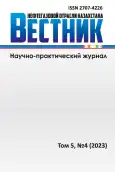Increasing the efficiency of the bactericide use at PS-4 of "Ozenmunaigas" JSC
- Authors: Alzhanov N.K.1, Berkutaliyeva S.K.1, Tleshev M.T.1
-
Affiliations:
- KMG Engineering
- Issue: Vol 5, No 4 (2023)
- Pages: 60-73
- Section: Oil and gas field development and exploitation
- URL: https://journal-vniispk.ru/2707-4226/article/view/249936
- DOI: https://doi.org/10.54859/kjogi108640
- ID: 249936
Cite item
Full Text
Abstract
Background: The study is devoted to increasing the efficiency of bactericidal treatment of sediments at the oil fields of Ozenmunaigas JSC. Calculations were carried out to assess the capability of heating the formation and the pipeline, hydraulic heat loss when injecting a bactericide, and the efficiency of mixing the reagent with water. The analysis revealed the ineffectiveness of mixing the bactericide with water at low temperatures and rates of inhibitor introduction.
Aim: The purpose of the study was to identify solutions to overcome the problems caused by the increased content of hydrogen sulfide in the fields of Ozenmunaigas JSC. This included addressing the temperature issues during bactericide delivery and increasing the rate of inhibitor injection.
Materials and methods: Heat loss calculations were carried out using the UniSim program for both tank heating and input lines, as well as an analysis of bactericide mixing inside the pipeline using the ANSYS program.
Results: The results of the study led to specific recommendations and measures that could mitigate the problems associated with temperature and rate of injection. These included measures such as heating and insulation, temperature control, regular inspection of thermal insulation, and selection of a new reagent with improved mixing properties at lower temperatures. It is also recommended to install reagent flow and temperature sensors along with power supply control.
Conclusion: The implementation of the proposed measures will effectively solve the problems associated with high levels of hydrogen sulfide. This approach will ensure a smooth and safe flow of bactericide and help maintain the operating efficiency of the affected facilities.
Full Text
##article.viewOnOriginalSite##About the authors
Nursultan K. Alzhanov
KMG Engineering
Author for correspondence.
Email: n.alzhanov@niikmg.kz
Kazakhstan, Astana
Sandugash K. Berkutaliyeva
KMG Engineering
Email: s.berkutaliyeva@niikmg.kz
Kazakhstan, Astana
Maksat T. Tleshev
KMG Engineering
Email: m.tleshev@niikmg.kz
Kazakhstan, Astana
References
- Imanbayev BA, Zhaparov NS, Maksut DM, Utepov MS. Methods of combating biogenic hydrogen sulfur at the Uzen and Karamandibas oilfield. Kazakhstan journal for oil & gas industry. 2021;3(4):77–90. doi: 10.54859/kjogi99709.
- Zhang J, Song Y, Su H, et al. Investigation of DiospyrosKaki Lf husk extracts as corrosion inhibitors and bactericide in oil field. Chemistry Central Journal. 2013;7(1):1–6.
- Kong L, Zhang B, Fang J. Study on the applicability of bactericides to prevent concrete microbial corrosion. Construction and Building Materials. 2017;149:1–8.
- Elguindi J, Moffitt S, Hasman H, et al. Metallic copper corrosion rates, moisture content, and growth medium influence survival of copper ion-resistant bacteria. Applied microbiology and biotechnology. 2011;89:1963–1970.
- Samedov AM, Alieva LI, Abbasov VM. Inhibitive and bactericidal effects of natural naphthenates on steel corrosion in sea water. Protection of metals. 2008;44(4):397–401.
Supplementary files

























